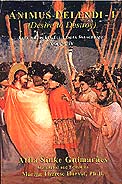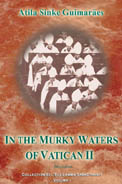 |
Book Reviews
Deadly Ambiguity
Bishop Richard Williamson
Book-review on Animus Delendi I and In the Murky Waters of Vatican II
by Atila Sinke Guimarães


Click in the pictures to purchase |
The flier [sent with the letter] presents the first two volumes to have appeared in what is due to be a massive eleven-volume analysis …. of the Second Vatican Council itself by a Brazilian layman now living in the USA, Mr. Atila Sinke Guimarães.
The series is entitled Eli, Eli Lamma Sabacthani?, which is Our Lord’s cry of distress from the Cross. “My God, my God, why hast Thou forsaken me?” Clearly the series will say that the Second Vatican Council was like another crucifying of Our Lord. Volume I, In the Murky Waters of Vatican II, appeared in 1997. Volume IV, Animus Delendi (Desire to Destroy) appeared last year (2000). Mr. Guimarães hopes to publish the remaining nine volumes one a year for the next nine years, which is a major undertaking and “a consummation devoutly to be wished.”
Mr. Guimarães describes in Volume I how he was a disciple of Dr. Plinio Corrêa de Oliveira, the founder of TFP (Tradition, Family, Property) a major post-war lay Catholic movement launched in Brazil and now spread through many countries. It was Dr. Plinio who in 1982 asked Mr. Guimarães to undertake his analysis of Vatican II. For 16 years Mr. Guimarães plunged into study of a mass of sermons, speeches, writings, books by the masters spirits of the Council. His conclusions, traditional rather than conservative, have caused a separation between himself and TFP, so that now he is publishing on his own. Nevertheless, at the beginning of Volume I, he pays handsome tribute to the late Dr. Plinio and to TFP, because he received so much from them both ….
As for the SSPX, it can only approve of Mr. Guimarães’ no longer being with the TFP leaders because of their implicit acceptance of the Council. However, that does not mean that the SSPX approves of everything he says, any more than he must agree with everything said and done by the SSPX. In fact in these first two volumes to appear, there is no trace of the SSPX and little trace of Archbishop Lefebvre. No matter. As Othello says, “it is the cause, my soul, it is the cause,” and Mr. Guimarães renders great service to the cause of Catholic Tradition.
In the first volume he presents the plan of all eleven volumes: volume I, the “letter” of Vatican II, volumes II to V, the “spirit of the Council,” volumes VI to XI the thinking and fruits of the Council.
In volume I he declares that the hall-mark of Vatican II is ambiguity. In the General Introduction he writes: “After some time of analysis and reflection, we reached the conclusion that it is difficult to harmonize the conciliar texts amongst themselves. They present a fundamental dichotomy (split) of language …. Conciliar language appeared to us to have been designed to be able to be interpreted from the standpoint either of sound and traditional Catholic doctrine, or, surprisingly enough, of the teachings of the neo-modernist current, which has installed itself in many key positions in today’s Church. Such language appears to be a masterpiece of sustained doubletalk. Woven like precious Flemish lace out of the precious threads of the vocabulary of Tradition, it nevertheless appears the specter of a quite different mentality. Thus progressivism entered the official documents of the Magisterium with its head decorously covered by the laced veil of the old traditional language” (pp. 35-38, translation slightly adapted).
Here Mr. Guimarães is right on target. The Vatican II documents are a continual mixture of two things: Catholicism and Revolution. As long as one insists that these unmixables will mix, one is affirming that contradictories do not contradict, one is suspending in one’s head the law of non-contradiction, and one is destroying one’s ability to think. Divine Wisdom says: “I hate a mouth with a double tongue” (Prov. 8:13). Among other things, a double tongue rots the brain ….
Ambiguity is indeed the key to Vatican II, and it is the key to Mr. Guimarães presentation of Vatican II in the rest of volume I. He ends with two chapters on the destruction, by ambiguity, of the Church’s faith and unity of her clergy and laity. That stands to reason. Documents designed to satisfy at one and the same time conservatives and progressivists were bound to justify contradiction, which was in turn bound to generate contradiction, civil war and mutual destruction inside the Church.
The other volume of Mr. Guimarães presented in the enclosed flier is not actually volume II but volume IV, the first part of “Desire to Destroy,” and he means next to publish volume V. This is because he wishes to lay bare the directly destructive element at work in Vatican II, a.k.a. the Revolution. With a mass of direct quotations from the masterminds who direct Vatican II intellectually and politically, he shows how it was their deliberate intention to destroy the hierarchical sacred and militant Catholic Church. These progressivists had a design (chapter 1) to empty the Church (chapter 2), a clear plan (chapter 3) to level down the Church as a monarchy (chapter 4), to discredit her as a teacher of Truth (chapter 5), to dissolve her holy and Roman character (chapter 6), and by these means to fabricate a new Church (chapter 7).
Interestingly, Mr. Guimarães “Desire to Destroy” shows clearly that in the villain’s own writings, they have not hidden that which they still felt the need to disguise by ambiguity at Vatican II, in order to gain control of the Church. So the disguise at the Council may have been good, but the Council’s churchmen should have known better. (Some Bishops did). Conclusion – “Watch and pray.” And read Eli, Eli, Lamma Sabacthani?….
These reviews are excerpts from a letter (July 1, 2001)
to friends and benefactors of the Society St. Pius X
by Bishop Richard Williamson
|
More on these books
In the Murky Waters & Animus Delendi I

Book Reviews | Home | Books | CDs | Search | Contact Us | Donate

© 2002-
Tradition in Action, Inc. All Rights Reserved
|
 |

|
